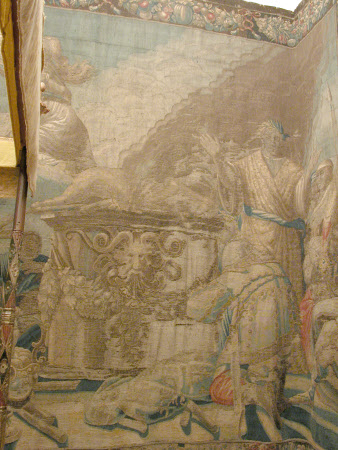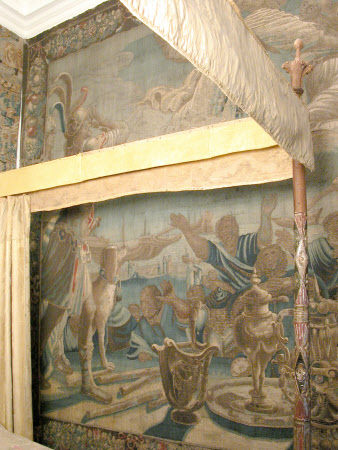The Sacrifice of Iphigenia
Pieter de Cracht (fl.1648 - 1662)
Category
Tapestries
Date
circa 1648 - circa 1662
Materials
Tapestry, wool and silk, 5 warps per cm
Measurements
3120 x 4850 mm
Order this imageCollection
Cotehele, Cornwall
NT 348311
Summary
Tapestry, wool and silk, 5 warps per cm, The Sacrifice of Iphigenia, Pieter de Cracht, Schoonhoven or Gouda, c. 1648-1662. In the centre-right, on a large marble altar carved with a lion mask and swags of fruit, a sacrificial goat is in flames. Iphigenia, who has been rescued from the altar at the last moment, is plucked up into the sky by the goddess Artemis who wears a crescent moon on her forehead. To the right of the altar stands a priest wearing a golden robe and a laurel wreath, raising his arms as he oversees the sacrifice. A crowd of soldiers and other people watch from the right, including in the foreground King Agamemnon, Iphigenia’s father, kneeling and wearing a crown atop his turban, and a figure in armour kneeling before the altar with his back to us. To the left of the scene are a man in armour with long plumes on his helmet, a man wearing blue robes and a turban, and a hound, all looking up in surprise at Iphigenia as she is carried away into the clouds. In the foreground before the altar are a number of rich golden vessels along with wood for the fire, and from behind the altar more figures watch the scene with arms upraised in shock and surprise. In the distance is a port scene with small figures on a jetty and a fleet of war ships moored. The tapestry has fairly narrow borders with foliage and ribbons on a brown ground.
Full description
The tapestry is one of a series known as ‘The Story of Iphigenia and Orestes’. Although only one tapestry from the set survives at Cotehele there was originally at least one more: a horizontal border from the series is attached to the top of ‘The Twins share out the Loot’ from the ‘Story of Rome’, hanging in the South Room. The sacrifice of Iphigenia occurs at the beginning of the Trojan War. The story is only alluded to in Homer’s ‘Iliad’; the fullest accounts are in Euripides’s play ‘Iphigenia at Aulis’, and the ‘Oresteia’ of Aeschylus. King Agamemnon, the Commander in Chief of the Greek forces, had paused with his fleet at Aulis on the way to Troy. He or his troops offended the Goddess Artemis, some accounts say by killing a hind that was sacred to her, and she punished Agamemnon by stilling the winds so that his ships could not leave Aulis. An Oracle told Agamemnon that Artemis would only allow the fleet to continue to Troy if he sacrificed his daughter, Iphigenia. Agamemnon, convinced that his own honour and that of the Greek nation rested on the Trojan war, wrote to his wife Clytemnestra with a story that Iphigenia was to be married to Achilles and was to come to Aulis immediately. He later regretted his decision and sent a second letter which was intercepted by Menelaus, his brother, and the husband of Helen, whose flight with Paris had prompted the Greek expedition to Troy. Soon after they arrived at Aulis Iphigenia and Clytemnestra discovered that they had been tricked; Achilles too discovered how his name had been used and vowed to protect Iphigenia. However the Greek Army soon discovered the Oracle’s prophecy and demanded that the girl be killed to enable them to go to war. In Euripides’ account Iphigenia eventually decided to sacrifice herself for the greater good of Greece and of her father, inspiring great admiration from Achilles. The actual sacrifice is described by a messenger to Clytemnestra after the event. He relates how the entire Greek army had gathered in a clearing to see the sacrifice, and how when Iphigenia was led to the altar Agamemnon groaned and covered his eyes with his cloak – as he can be seen doing in the tapestry. The others present were the seer Calchas, and the son of Peleus who was to carry out the sacrifice – he may be the man kneeling in the foreground. The girl was laid on the altar and as the priest prepared to strike her neck, and all the onlookers were gazing sadly at the ground, there was a thud and they looked up to see a deer on the altar in her place (other sources say that the animal was a goat). Iphigenia had been rescued at the last moment by Artemis herself and carried away to the country of the Taurians where she became a priestess in Artemis’s temple. The soldier watching on the left of the tapestry may be intended for Achilles. The most complete surviving set of ‘Iphigenia and Orestes’ tapestries is in the Rijksmuseum, Amsterdam, and includes the following five subjects: ‘The Death of a Stag dedicated to Artemis’; ‘Orestes’ Revenge on Aigistos’; ‘Orestes and Pylades before Iphigenia’; ‘King Rhoas and the Goddess Athena’; and ‘The Return of Orestes and Iphigenia to Aulis’ (Hartkamp-Jonxis and Smit 2004, pp. 241-250). In 2006 the Rijksmuseum acquired a sixth tapestry from the series representing ‘The Intervention of Artemis at the Sacrifice of Iphigenia’, which corresponds to the tapestry at Cotehele. This was probably the second or third subject in an original series of eight. The six tapestries now in the Rijksmuseum all have the same architectural border consisting of Salomonic columns at the sides, swags of fruit and flowers tied to a stone parapet at the top, and a stone ledge at the bottom decorated with acanthus leaves. This is wider and far more elaborate than the border on the Cotehele panel, which consists of narrow swags of fruit tied with ribbons on a plain brown ground. In addition the Cotehele panel is far more coarsely woven than the Rijksmuseum examples, at 5 warps per cm as opposed to 7 warps per cm. Although neither the Rijksmuseum set nor the panel at Cotehele bears any kind of signature, the series has been securely attributed to the Dutch tapestry merchant and weaver Pieter de Cracht (d. c. 1662). In 1648 de Cracht sold eight tapestries of the ‘History of Iphigenia and Orestes’ to the Elector of Brandenburg. Two years later another ‘Iphigenia and Orestes’ set is listed in a contract to supply six tapestry ‘chambers’ to the dealers Jan and Arnoult van Hagen, who had offices in Amsterdam and Stockholm; these tapestries were sent to Stockholm and may subsequently have been supplied to the Swedish crown (van Ysselsteyn 1936, vol. I, pp. 146-8). Further evidence is provided in a document of 1649, in which de Cracht offered ‘Iphigenia’ tapestries to a Swedish admiral, Gustav Wrangel (Hartkamp-Jonxis and Smit 2004, pp. 178-9). None of these tapestries is known to survive, unless the Rijksmuseum series, whose provenance is not known, is one of them. The only other survival is a set of four, including ‘The Intervention of Artemis in the Sacrifice of Iphigenia’, in a German private collection, bearing the monogram of Werner Altgraf Salm and Maria Limburg (Hartkamp-Jonxis and Smit 2004, p. 241). None of de Cracht’s surviving tapestries are signed, so they are attributed to him on the basis of circumstantial and stylistic evidence. The set of six tapestries in the Rijksmuseum can be linked to de Cracht’s recorded ‘Iphigenia’ tapestries for three reasons. First, no other ‘Iphigenia’ tapestries are known to have been made in this period aside from a set in France, which are clearly unrelated. Secondly, the borders of the Rijksmuseum set, although of a type originating in the Southern Netherlands with tapestries designed by Rubens, appear almost exactly replicated on various Northern Netherlandish tapestry series, notably ‘The History of Mark Anthony and Cleopatra’, woven in more than one Dutch workshop including that of Naulaert Nauwincx, de Cracht’s father-in-law, and de Cracht himself (Hartkamp-Jonxis and Smit 2004, p. 180). Thirdly, the surviving ‘Iphigenia’ tapestries have strong stylistic links to other tapestries attributed to de Cracht, and to northern Netherlandish tapestry design more generally in the 1640s and 1650s. The design of the ‘Iphigenia’ series has been attributed to the Haarlem artist Salomon de Bray (1597 – 1664). Like de Cracht, de Bray’s father was an immigrant from the Southern Netherlands; nonetheless de Bray is thought to have been a Catholic. His most important commission was for a series of three large canvases for the Huis ten Bosch at the Hague. It is on the basis of their similarity to these paintings in particular that the ‘Iphigenia’ tapestries have been linked to de Bray (Erkelens 1979 pp. 5, 9; Hartkamp-Jonxis and Smit 2004, pp. 241-3). The tapestry has been at Cotehele since at lease c. 1840, when it was recorded in a watercolour by Nicholas Condy hanging in the South Room (then known as the ‘Best Room’). In his accompanying text the Rev. Arundell described it as “another piece finely executed, of which the subject is a sacrifice, and seems to refer to the story of Diana and Endymion.” (Arundell 1840, p. 27). (Helen Wyld, 2010)
Provenance
First recorded at Cotehele c. 1840; left at Cotehele when the property was accepted in lieu of tax from Kenelm, 6th Earl of Mount Edgcumbe (1873-1965) and transferred to the National Trust in 1947; amongst the contents accepted in lieu of estate duty by H M treasury and transferred to the National Trust in 1974.
Credit line
Cotehele House, The Edgcumbe Collection (The National Trust)
Makers and roles
Pieter de Cracht (fl.1648 - 1662), workshop attributed to Salomon de Bray (Amsterdam 1597 - Haarlem 1664) , designer
References
Hartkamp-Jonxis and Smit, 2004: Ebeltje Hartkamp-Jonxis and Hille Smit, European Tapestries in the Rijksmuseum, Amsterdam 2004 Hartkamp-Jonxis, 2002: Ebeltje Hartkamp-Jonxis, ‘Flemish Tapestry Weavers and Designers in the northern Netherlands’, in Guy Delmarcel (ed.), Flemish Tapestry Weavers broad: emigration and the founding of manufactories in Europe, Leuven 2002, pp. 15-42 Blankert, 1999: Albert Blankert (ed.), Dutch Classicism in seventeenth-century painting, exh. cat., Rotterdam and Frankfurt 1999 Erkelens, 1971: A M Louise Erkelens, ‘Wandtapijten 2. Renaissance, Manierisme en Barok. Rijksmusem. Facetten der verzameling, 2nd series, vol. 5 (1971) van Ysselsteyn, 1936: G T van Ysselsteyn, Geschiedenis der tapijtweverijen in de noordelijke Nederlanden. Bijdrage tot de geschiedens der kunstnijverheid, 2 vols., Leiden 1936




